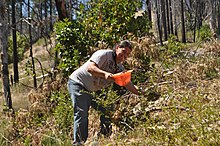The Karuk people (Karok: káruk va'áraaras)[3] are an indigenous people of California, and the Karuk Tribe is one of the largest tribes in California.[2] Karuks are also enrolled in two other federally recognized tribes, the Cher-Ae Heights Indian Community of the Trinidad Rancheria[4] and the Quartz Valley Indian Community.
káruk va'áraaras | |
|---|---|
 Karuk leader Ron Reed collecting gooseberries (2014) | |
| Total population | |
| 2010 census: 6,115 alone and in combination[1] | |
| Regions with significant populations | |
| California (Yreka, Happy Camp, Orleans), Oregon[2] | |
| Languages | |
| English, Karuk | |
| Religion | |
| Christianity, other | |
| Related ethnic groups | |
| Yurok |
Happy Camp, California, is located in the heart of the Karuk Tribe's ancestral territory, which extends along the Klamath River from Bluff Creek (near the community of Orleans in Humboldt County) through Siskiyou County and into Southern Oregon.[5]
Name
The name "káruk ," also spelled "Karok," means "upriver",[6][3] or "upstream",[7] whereas the word "yúruk" means "downriver".[3] Thus, the term "káruk va’áraaras" refers to Karuk people, literally meaning "upriver people", whereas the exonym of the Yurok people in English, is derived from Karuk language term "yúruk va’áraaras", meaning "downriver people.[3]
Historically, "káruk va’áraaras" referred to any people from upriver of a reference point or person speaking. Traditionally, Karuk people referred to themselves as "ithivthanéen’aachip va’áraaras", meaning "middle of the world people".[3]
Karuk people are called Chum-ne in the neighboring Tolowa language.[8]
Language
The Karuk people speak the Karuk language, a language isolate.[9] The tribe has an active language revitalization program.[10]
Population
Estimates for the population sizes of most Native groups before European arrival in California have varied substantially.[a] Alfred L. Kroeber proposed a population for the Karuk of 1,500 in 1770. Sherburne F. Cook initially estimated it as 2,000, later raising this figure to 2,700.[11][12] In 1910, Kroeber reported the surviving population of the Karuk as 800.[6]: 883
According to the 2010 census, there were 6,115 Karuk individuals, of which 3,431 were full-blooded.[1]
Culture

Since time immemorial, the Karuk resided in villages along the Klamath River, where they continue such cultural traditions as hunting, gathering, fishing, basketmaking and ceremonial dances.[5] The Karuk were the only California tribe to grow tobacco plants.[7] The Brush Dance, Jump Dance and Pikyavish ceremonies last for several days and are practiced to heal and "fix the world," to pray for plentiful acorns, deer and salmon, and to restore social goodwill as well as individual good luck.[5]
The Karuk developed sophisticated usage of plants and animals for their subsistence. These practices not only consisted of food harvesting from nature, but also the use of plant and animal materials as tools, clothing and pharmaceuticals. The Karuk cultivated a form of tobacco,[7] and used fronds of the Coastal woodfern as anti-microbial agents in the process of preparing eels for food consumption.[13]
Karuk in film
- Andrew Chambers. 2008. Pikyáv (to fix it).[14] Documentary film produced for the Truly California series. KQED Public Television and C. Buried Star Productions.
Notable Karuk people
- Rob Cabitto, author of a memoir about his struggles with identity and addiction.
- Naomi Lang, figure skater; five time US Champion in ice dancing from 1999 to 2003. As a member of the 2002 US Olympic figure skating team, she was the first Native American woman to compete in the Winter Olympics. Her great-great-grandmother, Bessie Tripp, was a full blooded Karuk from Orleans/Salmon River.
- Buck Martinez, former professional baseball player and current play-by-play broadcaster for the Toronto Blue Jays.[15]
- Anthony Earl Numkena (Hopi/Karuk) (born 1942), actor, appeared in a number of films and television shows in the 1950s including being credited in Pony Soldier (1952) at the age of nine. His grandmother, Caroline Besoain, née Harrie, was three-quarters Karuk born in Somes Bar, California in 1899 and settled in Quartz Valley, California.
- Jetty Rae, musician whose grandmother, Jetty Rae Thom, was a full-blooded Karuk.[16]
- Cutcha Risling Baldy, associate professor Cal Poly Humboldt
- Fox Anthony Spears, artist and printmaker who uses geometric designs inspired by Karuk basketry patterns. Commissioned to design warmup jersey patches for Seattle Kraken’s Indigenous Peoples Night game in 2021.[17]
See also
Notes
- For estimates of population, see Population of Native California.
References
External links
Wikiwand in your browser!
Seamless Wikipedia browsing. On steroids.
Every time you click a link to Wikipedia, Wiktionary or Wikiquote in your browser's search results, it will show the modern Wikiwand interface.
Wikiwand extension is a five stars, simple, with minimum permission required to keep your browsing private, safe and transparent.
